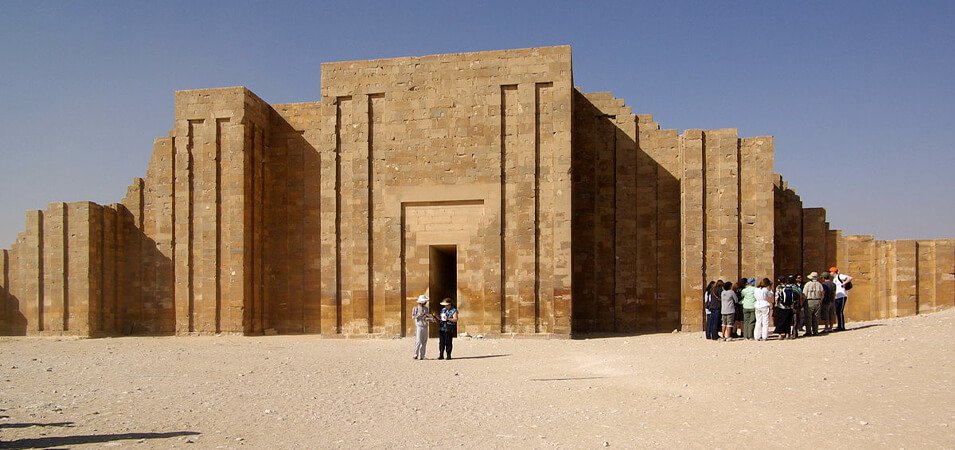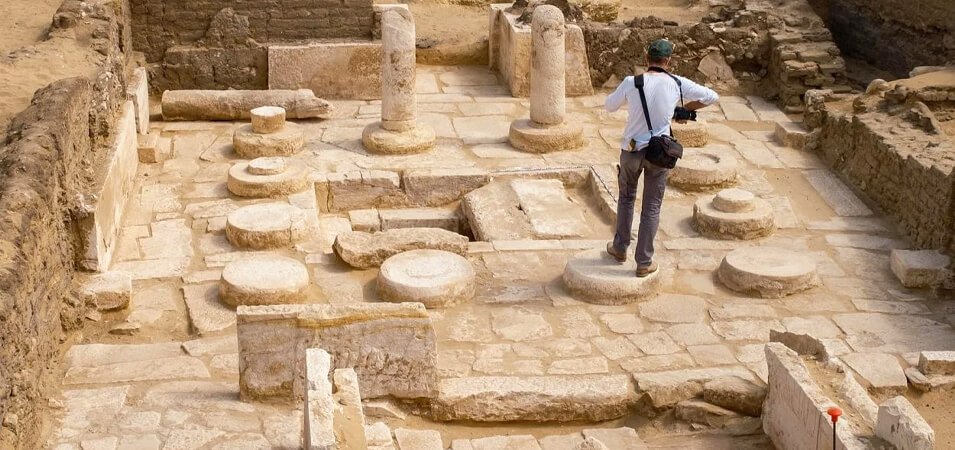Imagine a vast desert landscape dotted with colossal pyramids, ornate tombs, and hidden chambers whispering tales of a bygone era. This is the Necropolis of Saqqara, an ancient Egyptian burial ground that stands as a testament to the pharaohs’ power and the enduring allure of the afterlife.
For over 3,000 years, Saqqara served as the primary necropolis for Memphis, the once-powerful capital of ancient Egypt. A necropolis, in essence, is a “city of the dead,” a designated area for burials and rituals associated with the afterlife. Unlike our modern cemeteries, necropolises in ancient Egypt were sprawling complexes teeming with life – the life dedicated to honoring the deceased. Here, priests performed elaborate ceremonies, artisans crafted exquisite tombs, and families mourned their loved ones.
The Evolution of Burials at Saqqara
Saqqara’s story unfolds like a captivating scroll, revealing the ever-changing tapestry of Egyptian beliefs about death and the afterlife. During the Early Dynastic Period (3100-2686 BCE), Egyptians primarily used mastabas – flat-roofed, rectangular tombs – for burials. These early mastabas were often modest, reflecting a simpler view of the afterlife. However, as the Old Kingdom (2686-2181 BCE) dawned, Saqqara witnessed a monumental shift. The brilliant architect Imhotep, serving under Pharaoh Djoser, revolutionized funerary architecture with the construction of the Step Pyramid. This towering structure, a massive six-tiered pyramid, marked a significant leap in both symbolic and technological advancements.
The following dynasties (Middle Kingdom, New Kingdom) saw a surge in the construction of pyramids at Saqqara, each reflecting the evolving styles and beliefs. Pyramids became more elaborate, with causeways connecting them to valley temples dedicated to the pharaoh’s rituals. Tomb decoration also flourished during this time. The walls of tombs like that of Mereruka came alive with vibrant scenes depicting daily life, religious ceremonies, and offerings – a testament to the Egyptians’ desire to ensure a comfortable afterlife for the deceased.

Evolution of Burial Practices at Saqqara:
- Early Dynastic Period (3100-2686 BCE): Simple mastaba tombs reflecting a basic view of the afterlife.
- Old Kingdom (2686-2181 BCE): Construction of the revolutionary Step Pyramid by Imhotep under Djoser.
- Middle Kingdom & New Kingdom: Rise of more elaborate pyramids with causeways and valley temples. Flourishing of tomb decoration depicting daily life and religious scenes.
- Greco-Roman Period (332 BCE-395 CE): Shift towards simpler burials and rise of cults dedicated to Isis and Osiris.
A Traveler’s Guide to Saqqara
So, you’re ready to embark on your own Egyptian adventure and explore the wonders of Saqqara? Here’s everything you need to know to plan a memorable visit:
Getting There:
Located around 20 kilometers south of Cairo, Saqqara is easily accessible. You have several options:
- Private Tour: The most convenient option, a private tour from Cairo takes care of transportation, entrance fees, and often includes an Egyptologist guide for insightful commentary.
- Taxi: Negotiate a fare with a taxi driver beforehand. This option offers flexibility but requires some Arabic or a travel app for navigation.
- Public Transportation: Taking the metro from Cairo to El Monib station followed by a microbus to Saqqara village and a final tuk-tuk ride to the site is a budget-friendly option, but requires some planning and patience.
Planning Your Visit:
Entrance Fees: Check the official website of the Egyptian Ministry of Tourism and Antiquities for the latest entrance fee information. Typically, student discounts are available.
Hours of Operation: Saqqara is generally open from 8:00 AM to 5:00 PM, but it’s wise to double-check before your visit.
What to Wear: Opt for comfortable, loose-fitting clothing that covers your shoulders and knees. Sun protection, a hat, and sturdy walking shoes are essential for the desert climate.
Exploring the Site:
Saqqara is vast, so plan your itinerary beforehand. Here are some helpful tips:
- Purchase a Site Map: This will help you navigate the key monuments and plan your route.
- Hire a Local Guide: An experienced guide can provide invaluable insights and historical context.
- Pace Yourself: Exploring Saqqara takes time. Don’t try to see everything in one go – prioritize the monuments that most interest you.
Beyond Saqqara:
Combine your visit with other nearby historical gems:
- Memphis: The ancient capital of Egypt, boasting impressive ruins and statues.
- Dahshur: Home to the Bent Pyramid and the Red Pyramid, offering a glimpse into different pyramid construction techniques.
With a little planning and this guide, you’re all set to experience the magic of Saqqara and create lasting memories of your Egyptian adventure!
A Legacy Etched in Stone: The Enduring Power of Saqqara
Saqqara stands as a testament to the enduring power of human belief and the ingenuity of a civilization that continues to captivate us today. For over three millennia, it served as a stage for elaborate rituals, a canvas for artistic expression, and a final resting place for pharaohs, nobles, and ordinary people. Through the sheer scale and variety of its monuments, Saqqara offers a window into the evolution of Egyptian funerary practices, religious beliefs, and artistic styles.
Studying the tombs at Saqqara has unveiled fascinating details about daily life, social structures, and the Egyptians’ profound belief in the afterlife. The artistry adorning the tomb walls provides a glimpse into their hopes, fears, and aspirations. Saqqara is more than just a necropolis; it’s a living museum whispering stories of a bygone era.
Experience the Magic of Saqqara:
- Immerse yourself in history: Explore the Step Pyramid, marvel at the hieroglyphics, and stand in the shadows of these ancient wonders.
- Unveil the secrets of the tombs: Discover the vibrant scenes depicting daily life and religious practices, offering a glimpse into the past.
- Connect with a bygone era: Imagine the rituals, processions, and lives that unfolded within the vast necropolis.
So, are you ready to embark on a journey through time? Let Saqqara transport you to a world of pharaohs, gods, and enduring belief. This necropolis awaits, ready to unveil its secrets and ignite your imagination.

Conclusion
Our exploration of Saqqara has unveiled a treasure trove of ancient Egyptian history. We’ve journeyed through time, witnessing the evolution of burial practices, marveling at architectural marvels, and gaining insights into the beliefs of a bygone era. Saqqara’s enduring legacy serves as a powerful reminder of human ingenuity and the enduring power of the past.
This is just the beginning. Dive deeper into the captivating world of Saqqara and ancient Egypt. Explore the resources listed below to fuel your curiosity and plan your own adventure to this remarkable necropolis
FAQs
1. Is Secrets of the Saqqara Tomb a real documentary?
Yes, “Secrets of the Saqqara Tomb” is a real documentary film released in 2020 that follows the excavation of a previously unopened tomb complex.
2. Was the 4500-year-old tomb discovered?
There are frequent archaeological discoveries in Saqqara, but the documentary focuses on a tomb complex from the 25th century BC, which is roughly 4,400 years old.
3. What does the Saqqara reveal to us about ancient Egypt?
- Saqqara reveals a vast amount of information about ancient Egyptian civilization, including:
- Evolution of burial practices and funerary beliefs over thousands of years.
- Artistic styles and techniques used in tomb decoration.
- Social structures and daily life through depictions in tombs.
- Religious beliefs through the presence of deities like Ptah and the Apis bulls.
4. What is unique about Saqqara?
Here’s what makes Saqqara unique:
- Sheer size and longevity of use as a necropolis for over 3,000 years.
- Variety of monuments, including pyramids from different dynasties, elaborate tombs, and hidden chambers.
- Importance as a religious center with temples dedicated to Ptah and the vast Serapeum for the Apis bulls.
- New discoveries of Saqqara: The blog outline focused on historical context, so it doesn’t delve into recent discoveries. However, archaeological digs at Saqqara are ongoing, and new finds are always being announced.
5. Is Saqqara older than Giza?
While both are significant necropolis, Saqqara’s use began earlier than Giza. The earliest mastabas at Saqqara date back to the Early Dynastic Period (around 3100 BCE), while the Giza Pyramids were constructed during the Old Kingdom (around 2686-2181 BCE).
Read other Related Articles:
